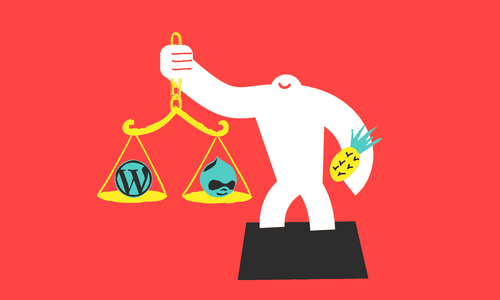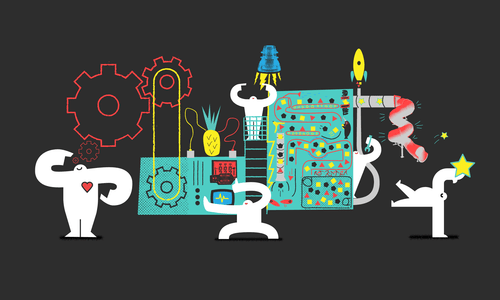
While certainly not the only P words for productivity, these four are importantly related to each other and are very important for the flow and happiness of high-performing teams.
Push
Traditional Project Management has its roots in a “Push” mindset for accomplishing its work. An example of “Push” would be where projects, or issues, emerge and are assigned to people who are subordinate to the assigner, typically the Project Manager.
On a Push model, the assigner can push the assignment without having to necessarily do any work themselves. To make someone else accountable, all they have to do is assign it, often with a due date, basically saying, “here you go, figure this out, good luck! Don’t worry, I’ll check in for status updates frequently!”
The problem here is that the newly assigned person never truly committed and will probably have valid reasons for not being able to accomplish the assignment on time, and so never feels true responsibility. This also cuts both ways. While people in a Push model won’t feel truly responsible if it fails, they also won’t feel truly responsible if it succeeds. This is critically important for job satisfaction, which impacts team health and, in the end, organizational performance.
Symptoms of problems with Push often start becoming visible as conversations start emerging between colleagues about “the job” not going so good. It hasn’t been fun for a while. There is always too much to do. Hiring people seems to make things worse. It takes too long to onboard them onto all there is for them to help with. No one has enough time.
It doesn’t start this way but it comes on quick with people getting assigned to a new project before the previous one finished and the tasks start piling up. A couple more projects in and one of them from a few months ago still needs the frequent fix or clean up. People start telling themselves they are just a little over resourced, they try to accept it and roll with it, but really gridlock is setting in.
Being over resourced means “multitasking” which is basically like being interrupted constantly whenever switching contexts between multiple tasks. This is incredibly frustrating, especially if these interruptions are being pushed upon us. The worst is when things start getting behind far enough that being asked for status updates starts to feel like, “If everyone would stop asking for a status update, I might be able to get something done on this project.”
Teams can be pushed into ways of working where the needed changes no longer seem intuitive, so they are easy to not think of. Layers of well meaning additional process piles up too, so digging out to even start making progress can seem impossible and definitely overwhelming. Here, the team is typically gridlocked under their (over)workload. One big change you might try to get your team to make is a switch from a “Push” to a “Pull” mindset.
Pull
An example of Pull would be where projects, or their issues, are made visible somewhere and the people who are to do the work know where to look for what’s next to do. They are able to ask questions until they are comfortable, then they pull the work to themselves and commit to doing it.
With Pull, the person bringing the work desired to be done, to the team, has their own work to do to make the requests as “pullable” as possible. Breaking down the work clearly, into prioritized pieces helps. Making sure that those that will pull the work are not getting overloaded, or stuck on a previous project, also becomes part of the organizational mindset.
Pull prevents burnout, improves job satisfaction, and reduces delivery times. Teams that follow a pull model can manage their own slack and focus on continuously improving their flow of issues to completion, without sacrificing quality. These teams will feel a true commitment to doing what they pull in and will naturally take full responsibility for its completion, whether a failure to be learned from or a success to be celebrated. Management, in a pull model, will need to be real about how much work their teams really can do well and they will need to manage external expectations accordingly. What management does put in to be pulled will receive true focus and will deliver faster as the team will not be juggling multiple projects at the same time.
Getting started with Put
If management won’t be assigning work to be done anymore, they will instead be putting work somewhere to be pulled. Where work will be put needs to be made explicit and agreed to as a team so that everyone on the team knows where to look for the work. This is usually the far left column of a team’s Scrum or Kanban board, but it could be any place that can be agreed on by those who are putting and pulling. One nice thing about using a column on a board is that it becomes very easy to also prioritize what’s put there so that it is very clear what to pull next.
Those putting work up to be pulled will also want to be prepared to discuss it. Extremely detailed specification can actually work against tasks being pulled and committed to as the questions and confusion increase proportionally to how much detail that there is to interpret. While it seems intuitive to try to preemptively solve this confusion by adding more detail, that only increases the amount that the team needs to interpret. The solution is actually to breakdown what is being requested into smaller pieces and specifying only so much to serve as a solid reference point for conversation. Then, as a team, use the skills that humans are really good at and build a shared understanding through real-time discussion of what’s wanted and why.
Communicate for Pulling
While pushing tasks on others requires no real communication to tell someone to do something, getting someone to pull something to themselves will often take at least a little bit. This extra effort pays off in what is gained from the conversation. Normally, all that will be needed is a regular team meeting for discussing the top priority items desired to be pulled next. Regularly building this shared understanding as a team aligns everyone on the goals to accomplish. Further, these discussions can focus on the “what” and the “why” of the work to be done, as, given the resulting team alignment on a shared understanding, the team should be trusted to determine the “how to do it” as they are pulling the work to do.
In general, outside of a regular team meeting, the same gains are achieved whenever a conversation of the “what” and “why” precedes someone committing to take something on. In this model, people truly commit and will hold themselves accountable authentically. This leads to them being trusted to take ownership over how they accomplish their work. When conversations of this kind are a regular part of the process, an openness and transparency will be experienced on a regular basis. When this is combined with the resulting increase in true commitments made and kept, trust will build proportionately across the entire team.
Moving faster with Passing
As the team experiences the value in a pull model, and the push model falls away, it will be important to make the concept of passing explicit. Without it, there will be confusion about handling reassignments while issues are in progress between multiple team members.
This scenario arises after an issue is pulled and started by someone. They work on it until they reach a point where it makes sense for someone else to contribute. Sometimes it will still be true that a conversation should precede the pull from another teammate, but, once tasks are started, most times it is possible to have developed understandings in the flow of the teamwork that amount to teammates being explicitly open for the “pass” when tasks reach certain points of progress. For example, “when that issue gets ready for review, pass it to me” or “would you be willing to help with this part and then pass it back?” Over time these types of agreements will become unspoken understandings. A team, in a pull model, which further gets good at passing will experience a sense of “just knowing” how to work together, much like a good soccer team would.
Reassignments in these cases would not be considered pushing issues on to other teammates as they are actually a form of explicit agreement that a teammate will be open to the pass. Teams that are doing a lot of passing, however, will want to be mindful that tasks aren’t piling up on people. This can be discussed in a quick daily meeting about work in progress in order to redistribute work if it is piling up and to freeze new work from being pulled in until the pile up is removed.
What’s left of Push?
Adopting a pull model puts management and the team on the same side of the work to be done. Switching from a push to a pull model will not prevent tasks from ever being pushed on the team, but when it does happen, it will be due to emergencies that the whole company can decide on how to deal with together. Continuously improving a pull model will then involve looking for ways to further prevent emergency push situations from arising. The team should naturally do this improvement work together during normal business hours comfortably in their pull model.
What are the results?
Teams in a pull model will experience better work by more skillsets. Those putting up work to be pulled will do more of the figuring out of the “what” and “why” while thinking through how it might break down into smaller pieces while still satisfying the original intentions. The quality of the work will also improve with their increased collaboration as the work is pulled to completion. Those pulling the work will better understand what they are working on, be able to focus on it, and be trusted to do it how it should be done. Due to this, the quality of their work will improve and it will deliver sooner.
Teams in a pull model will also experience continuously improving communication as they will be doing it more as an intrinsic part of the model. Regular communication builds a sense of openness and builds trust, which impacts team heath and organizational performance. Trust is a critical enabler for learning, continuously improving, and generally moving faster with higher quality.
Further, teams in a pull model will experience feeling true responsibility, as they are committing authentically, increasing job satisfaction. They will also experience increasing job satisfaction as their focus and flow improves. Trust thrives here too as the team will be committing to more, smaller and better defined, tasks with significantly improved chances of success. Commitments are the currency of trust; it increases as more commitments are made and kept.
A Push mindset has the potential to gridlock a company. A Pull mindset has the potential to unlock job satisfaction, team happiness, trust and a continuously improving flow of value to customers. Get started on your transition to Pull with Put and improve by regularly communicating and learning good Passing as a team. Finally, sustain your transition by working to continuously reduce the number of emergencies that may push themselves upon the team at any time. In the end, companies in a pull model will experience happier teams and happier customers.




